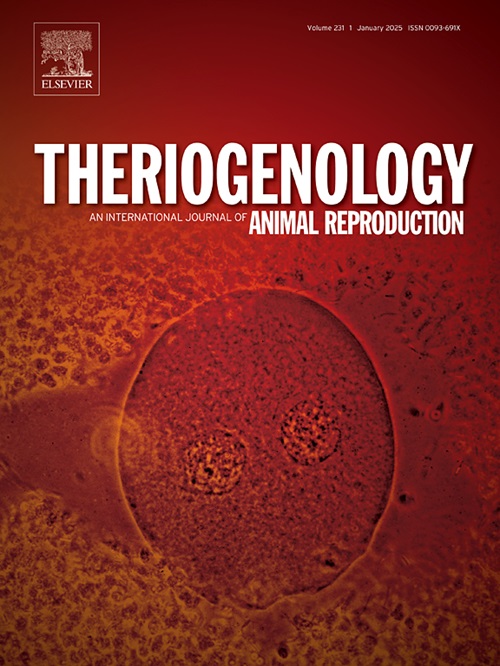Effect of porcine oviductal fluid-derived extracellular vesicle supplementation on in vitro embryonic developmental competence and the production efficiency of cloned pigs
IF 2.4
2区 农林科学
Q3 REPRODUCTIVE BIOLOGY
引用次数: 0
Abstract
Extracellular vesicles (EVs) derived from oviductal epithelial cells help with fertilization and embryo development. Although the effects of EVs on the developmental competence of somatic cell nuclear transfer (SCNT) embryos are known, their impact on the production efficiency of cloned pigs in surrogate mothers is unclear. We evaluated the effects of porcine oviductal fluid-derived EVs (oEVs) on the in vitro development of SCNT embryos and production efficiency in cloned pigs. Embryos were treated with isolated and characterized oEVs for 48 h, corresponding to the residence time of fertilized embryos in the oviduct. In both parthenogenetic activation (PA) and SCNT embryos, oEV-treated groups exhibited higher rate of blastocyst formation than the controls. Gene expression analysis revealed increased expression of genes essential for early embryonic development in four-cell stage SCNT embryos, including those involved in pluripotency (POU5F1; POU class 5 homeobox 1), genome stability (Zinc finger and SCAN domain containing 4), and DNA damage response (Checkpoint kinase 1). Additionally, gene expression analysis of blastocysts from SCNT embryos showed increased expression of pluripotency (POU5F1) and Wnt signal transduction (Axis inhibition protein 2). Transfer of day-2 in vitro cultured SCNT embryos into surrogate mothers revealed no significant difference in production efficiencies between the control and experimental groups. Thus, enhanced early embryonic developmental competence observed in vitro following oEV treatment of PA or SCNT embryos did not translate into improved production efficiency of cloned pigs following embryo transfer to surrogate mothers. Hence, the impact of oEV treatment on live birth outcomes requires further investigation.
添加猪输卵管液源性细胞外囊泡对克隆猪体外胚胎发育能力和生产效率的影响
来源于输卵管上皮细胞的细胞外囊泡(EVs)有助于受精和胚胎发育。虽然已知ev对体细胞核移植(SCNT)胚胎发育能力的影响,但其对代孕母克隆猪生产效率的影响尚不清楚。我们评估了猪输卵管液体衍生ev (oev)对克隆猪SCNT胚胎体外发育和生产效率的影响。胚胎用分离的和特征的oEVs处理48h,对应于受精胚胎在输卵管中的停留时间。在孤雌生殖激活(PA)和SCNT胚胎中,oev处理组的囊胚形成率均高于对照组。基因表达分析显示,在四细胞期SCNT胚胎中,早期胚胎发育所必需的基因表达增加,包括那些涉及多能性的基因(POU5F1;此外,对SCNT胚胎囊胚的基因表达分析显示,多能性(POU5F1)和Wnt信号转导(轴抑制蛋白2)的表达增加。将体外培养的SCNT胚胎转移到代孕母亲体内,对照组和实验组之间的生产效率没有显著差异。因此,oEV处理PA或SCNT胚胎后观察到的体外早期胚胎发育能力的增强并没有转化为胚胎移植给代孕母亲后克隆猪的生产效率的提高。因此,oEV治疗对活产结局的影响需要进一步研究。
本文章由计算机程序翻译,如有差异,请以英文原文为准。
求助全文
约1分钟内获得全文
求助全文
来源期刊

Theriogenology
农林科学-生殖生物学
CiteScore
5.50
自引率
14.30%
发文量
387
审稿时长
72 days
期刊介绍:
Theriogenology provides an international forum for researchers, clinicians, and industry professionals in animal reproductive biology. This acclaimed journal publishes articles on a wide range of topics in reproductive and developmental biology, of domestic mammal, avian, and aquatic species as well as wild species which are the object of veterinary care in research or conservation programs.
 求助内容:
求助内容: 应助结果提醒方式:
应助结果提醒方式:


